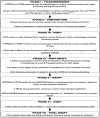Building consensus for the future of paediatric simulation: a novel 'KJ Reverse-Merlin' methodology
- PMID: 35518195
- PMCID: PMC8936676
- DOI: 10.1136/bmjstel-2015-000072
Building consensus for the future of paediatric simulation: a novel 'KJ Reverse-Merlin' methodology
Abstract
Objectives: This project aims to identify guiding strategic principles to optimise simulation-based educational impact on learning, patient safety and child health.
Methods: Study participants included 39 simulation experts who used a novel 'KJ Reverse-Merlin' consensus process in the systematic identification of barriers to success in simulation, grouped them in themes and subsequently identified solutions for each theme.
Results: 193 unique factors were identified and clustered into 6 affinity groups. 6 key consensus strategies were identified: (1) allocate limited resources by engaging health systems partners to define education and research priorities; (2) conduct and publish rigorous translational and cost-effectiveness research; (3) foster collaborative multidisciplinary research and education networks; (4) design simulation solutions with systems integration and sustainability in mind; (5) leverage partnerships with industry for simulation, medical and educational technology; (6) advocate to engage the education community, research funding agencies and regulatory bodies.
Conclusions: Simulation can be used as a research, quality improvement and or educational tool aimed at improving the quality of care provided to children. However, without organisation, strategy, prioritisation and collaboration, the simulation community runs the risk of wasting resources, duplicating and misdirecting the efforts.
Keywords: Consensus Statement; KJ Merlin; Pediatric Simulation; Simulation in Healthcare.
Published by the BMJ Publishing Group Limited. For permission to use (where not already granted under a licence) please go to http://www.bmj.com/company/products-services/rights-and-licensing/.
Conflict of interest statement
Competing interests: None declared.
Figures




Similar articles
-
The future of Cochrane Neonatal.Early Hum Dev. 2020 Nov;150:105191. doi: 10.1016/j.earlhumdev.2020.105191. Epub 2020 Sep 12. Early Hum Dev. 2020. PMID: 33036834
-
A research roadmap for complementary and alternative medicine - what we need to know by 2020.Forsch Komplementmed. 2014;21(2):e1-16. doi: 10.1159/000360744. Epub 2014 Mar 24. Forsch Komplementmed. 2014. PMID: 24851850
-
Student and educator experiences of maternal-child simulation-based learning: a systematic review of qualitative evidence protocol.JBI Database System Rev Implement Rep. 2015 Jan;13(1):14-26. doi: 10.11124/jbisrir-2015-1694. JBI Database System Rev Implement Rep. 2015. PMID: 26447004
-
Setting an Agenda: Results of a Consensus Process on Research Directions in Distance Simulation.Simul Healthc. 2023 Apr 1;18(2):100-107. doi: 10.1097/SIH.0000000000000663. Epub 2022 Apr 5. Simul Healthc. 2023. PMID: 36989108 Review.
-
Making inpatient medication reconciliation patient centered, clinically relevant and implementable: a consensus statement on key principles and necessary first steps.J Hosp Med. 2010 Oct;5(8):477-85. doi: 10.1002/jhm.849. J Hosp Med. 2010. PMID: 20945473
Cited by
-
Simulation-based clinical systems testing for healthcare spaces: from intake through implementation.Adv Simul (Lond). 2019 Aug 2;4:19. doi: 10.1186/s41077-019-0108-7. eCollection 2019. Adv Simul (Lond). 2019. PMID: 31388455 Free PMC article.
-
Ultrasound in Cardiopulmonary Arrest and Resuscitation: Constructing Comprehensive Implementation Frameworks in High-Risk Settings.Pediatr Emerg Care. 2024 Jun 1;40(6):469-473. doi: 10.1097/PEC.0000000000003165. Epub 2024 May 2. Pediatr Emerg Care. 2024. PMID: 38713851 Free PMC article.
-
Identifying Research Priorities in Digital Education for Health Care: Umbrella Review and Modified Delphi Method Study.J Med Internet Res. 2025 Feb 19;27:e66157. doi: 10.2196/66157. J Med Internet Res. 2025. PMID: 39969988 Free PMC article.
-
Conducting multicenter research in healthcare simulation: Lessons learned from the INSPIRE network.Adv Simul (Lond). 2017 Feb 28;2:6. doi: 10.1186/s41077-017-0039-0. eCollection 2017. Adv Simul (Lond). 2017. PMID: 29450007 Free PMC article.
References
-
- Cook DA, Hatala R, Brydges R, et al. . Technology-enhanced simulation for health professions education: a systematic review and meta-analysis. JAMA 2011;306:978–88. - PubMed
LinkOut - more resources
Full Text Sources
